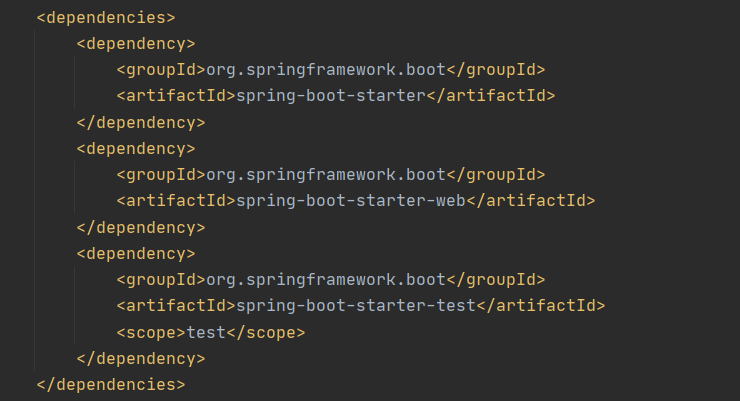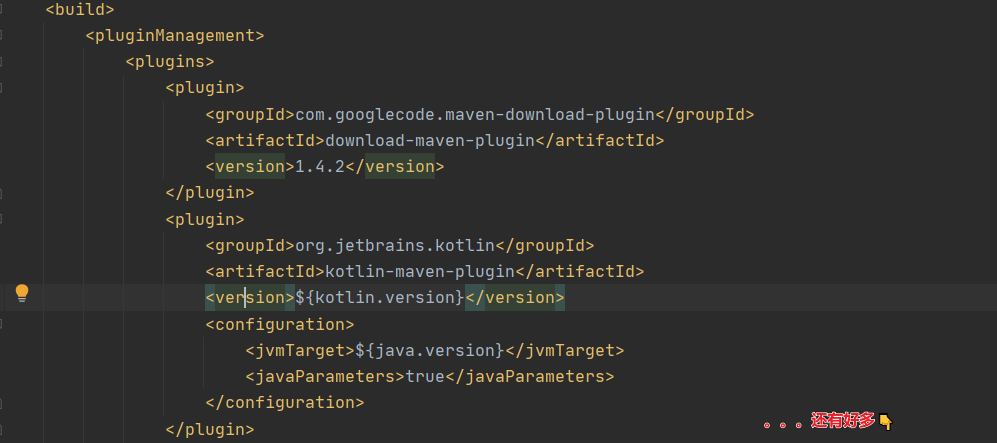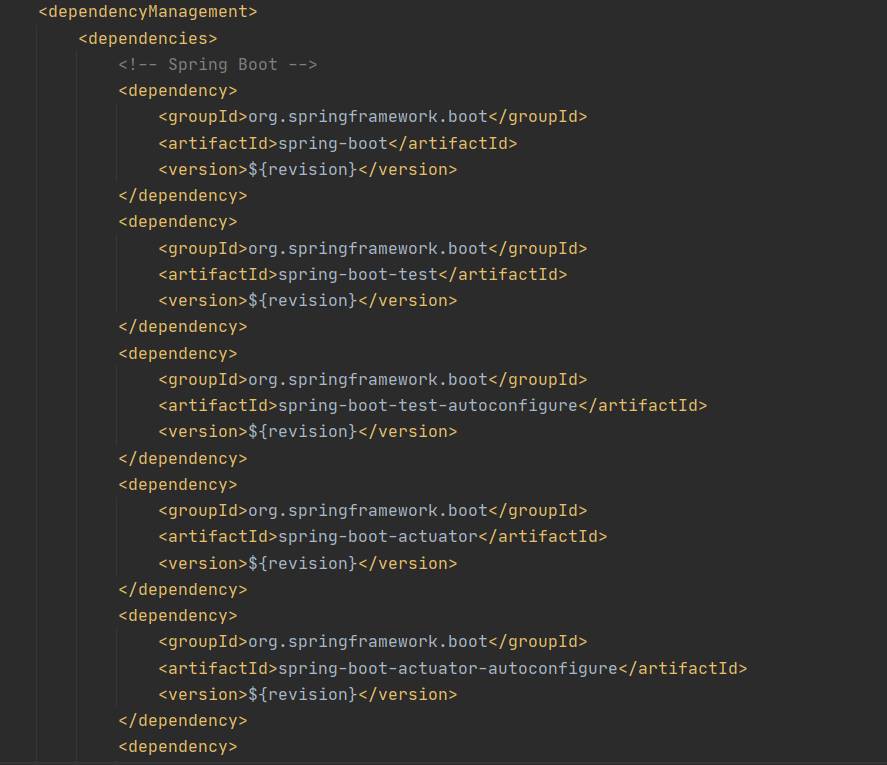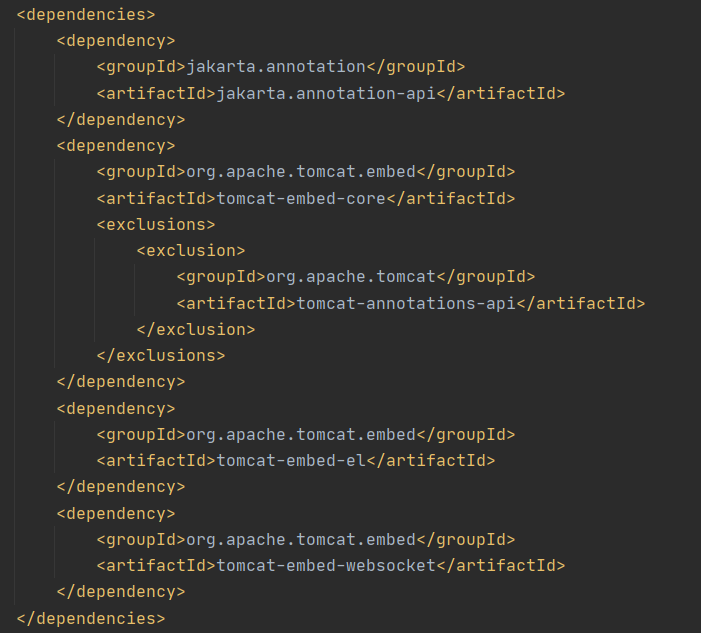SpringBoot dependency management source code analysis
1. Dependency management
Ⅰ. Why don’t you need to specify the version when importing some dependencies?

The dependencies we added when we created the project did not help us specify the version number, so how does SpringBoot specify the version account?
Now let’s peel off SpringBoot’s parent dependency starter
<!-- SpringBoot父项目依赖管理--> <parent> <artifactId>spring-boot-parent</artifactId> <groupId>org.springframework.boot</groupId> <version>2.2.9.RELEASE</version> <relativePath/> <!-- 查看本地仓库的源码 --> </parent>
1.1 The work of the parent dependency starter
The mouse pointer stays on spring -boot-parentUpCtrl left mouse buttonClick in, let’s take a look at what this parent dependency launcher is responsible for:
<parent>
<groupId>org.springframework.boot</groupId>
<artifactId>spring-boot-dependencies</artifactId>
<version>${revision}</version>
<relativePath>../spring-boot-dependencies</relativePath>
</parent>First go in and find: this parent dependency launcher There is a dad<>, as above! We will analyze this in depth later! ! !
Then continue to read
<properties>
<main.basedir>${basedir}/../..</main.basedir>
<disable.checks>false</disable.checks>
<git.url>https://github.com/spring-projects/spring-boot</git.url>
<git.connection>scm:git:git://github.com/spring-projects/spring-boot.git</git.connection>
<git.developerConnection>scm:git:ssh://git@github.com/spring-projects/spring-boot.git</git.developerConnection>
<java.version>1.8</java.version>
<project.build.sourceEncoding>UTF-8</project.build.sourceEncoding>
<project.reporting.outputEncoding>UTF-8</project.reporting.outputEncoding>
<maven.version>3.5.4</maven.version>
<maven-resolver.version>1.1.1</maven-resolver.version>
<spock.version>1.3-groovy-2.5</spock.version>
<spring-asciidoctor-extensions.version>0.4.0.RELEASE</spring-asciidoctor-extensions.version>
<spring-doc-resources.version>0.1.3.RELEASE</spring-doc-resources.version>
<spring-doc-resources.url>https://repo.spring.io/release/io/spring/docresources/spring-doc-resources/${spring-doc-resources.version}/spring-doc-resources-${spring-doc-resources.version}.zip</spring-doc-resources.url>
<testcontainers.version>1.12.5</testcontainers.version>
<testng.version>6.14.3</testng.version>
</properties>I see a property declaration here, declaring the jdk version, encoding format, packaged and compiled version, etc.; but this is just a statement! ! !
Let’s continue

This part is SpringBoot’s plug-in management
tips:
When importing plug-ins, since the <> management module plug-in here requires a specific version number, there is no need to consider plug-in version control.
1.2 Answer to the question
We Ctrl right-click <>, and as soon as we enter, we will see a series of version numbers:

The version numbers of many third-party frameworks are declared here. This corresponds to the version number of 2.2.9.RELEASE. If the SpringBoot version is changed, the version here will also change. But as mentioned before, <> is just a statement! ! !
We then

The reason why the project does not need to import the version number must be<>
tips:
spring-boot-starter-parent realizes the dependency management of SpringBoot by inheriting spring-boot-dependencies, so my Springboot project already has configurations such as version locking after inheriting spring-boot-starter-parent. Yes, this is why there is no need to write version numbers for partial dependencies in Spring Boot projects.
Ⅱ. Where does the JAR package that the project depends on come from?
Spring-Boot-Starter-Parent Parent Dependency Starter The main function is to carry out unified version management, so where does the JAR package that the project depends on come from?
2.1 Analyze the source code
We use < ;> For a breakthrough, we still click with the Ctrl left mouse button. In spring-boot-starter-web, we can clearly see a series of dependency management:
<dependencies> <dependency> <groupId>org.springframework.boot</groupId> <artifactId>spring-boot-starter</artifactId> </dependency> <dependency> <groupId>org.springframework.boot</groupId> <artifactId>spring-boot-starter-json</artifactId> </dependency> <dependency> <groupId>org.springframework.boot</groupId> <artifactId>spring-boot-starter-tomcat</artifactId> </dependency> <dependency> <groupId>org.springframework.boot</groupId> <artifactId>spring-boot-starter-validation</artifactId> <exclusions> <exclusion> <groupId>org.apache.tomcat.embed</groupId> <artifactId>tomcat-embed-el</artifactId> </exclusion> </exclusions> </dependency> <dependency> <groupId>org.springframework</groupId> <artifactId>spring-web</artifactId> </dependency> <dependency> <groupId>org.springframework</groupId> <artifactId>spring-webmvc</artifactId> </dependency> </dependencies>
We only introduce it in pom.xml Spring-boot-starter-web is a dependency (that is, it directly relies on the web dependency starter), and it relies on tomcat, springmvc, etc., which means that dependency transfer is carried out in this process, and we When you click on any dependency in the web dependency launcher, you will find that there are still many dependencies in it. Take tomcat as an example:

still contains everything needed to start tomcat. rely.
2.2 Answer to the question
At this point we can know that the main function of the spring-boot-starter-web dependency starter is to package all the dependencies of the Web development scenario (based on dependency delivery method, load the corresponding jar package in the current warehouse).
Just like this, when the spring-boot-stater-web dependency starter is introduced in pom. Dependency files, etc. Of course, the version numbers of these introduced dependency files are still managed uniformly by the spring-boot-starter-parent parent dependency (this is also an important manifestation of SpringBoot conventions are greater than configuration) Spring Boot provides In addition to the Web dependency launcher introduced above, it also provides related dependencies for many other development scenarios.
The above is the detailed content of SpringBoot dependency management source code analysis. For more information, please follow other related articles on the PHP Chinese website!

Hot AI Tools

Undresser.AI Undress
AI-powered app for creating realistic nude photos

AI Clothes Remover
Online AI tool for removing clothes from photos.

Undress AI Tool
Undress images for free

Clothoff.io
AI clothes remover

AI Hentai Generator
Generate AI Hentai for free.

Hot Article

Hot Tools

Notepad++7.3.1
Easy-to-use and free code editor

SublimeText3 Chinese version
Chinese version, very easy to use

Zend Studio 13.0.1
Powerful PHP integrated development environment

Dreamweaver CS6
Visual web development tools

SublimeText3 Mac version
God-level code editing software (SublimeText3)

Hot Topics
 1377
1377
 52
52
 How Springboot integrates Jasypt to implement configuration file encryption
Jun 01, 2023 am 08:55 AM
How Springboot integrates Jasypt to implement configuration file encryption
Jun 01, 2023 am 08:55 AM
Introduction to Jasypt Jasypt is a java library that allows a developer to add basic encryption functionality to his/her project with minimal effort and does not require a deep understanding of how encryption works. High security for one-way and two-way encryption. , standards-based encryption technology. Encrypt passwords, text, numbers, binaries... Suitable for integration into Spring-based applications, open API, for use with any JCE provider... Add the following dependency: com.github.ulisesbocchiojasypt-spring-boot-starter2. 1.1Jasypt benefits protect our system security. Even if the code is leaked, the data source can be guaranteed.
 How SpringBoot integrates Redisson to implement delay queue
May 30, 2023 pm 02:40 PM
How SpringBoot integrates Redisson to implement delay queue
May 30, 2023 pm 02:40 PM
Usage scenario 1. The order was placed successfully but the payment was not made within 30 minutes. The payment timed out and the order was automatically canceled. 2. The order was signed and no evaluation was conducted for 7 days after signing. If the order times out and is not evaluated, the system defaults to a positive rating. 3. The order is placed successfully. If the merchant does not receive the order for 5 minutes, the order is cancelled. 4. The delivery times out, and push SMS reminder... For scenarios with long delays and low real-time performance, we can Use task scheduling to perform regular polling processing. For example: xxl-job Today we will pick
 How to use Redis to implement distributed locks in SpringBoot
Jun 03, 2023 am 08:16 AM
How to use Redis to implement distributed locks in SpringBoot
Jun 03, 2023 am 08:16 AM
1. Redis implements distributed lock principle and why distributed locks are needed. Before talking about distributed locks, it is necessary to explain why distributed locks are needed. The opposite of distributed locks is stand-alone locks. When we write multi-threaded programs, we avoid data problems caused by operating a shared variable at the same time. We usually use a lock to mutually exclude the shared variables to ensure the correctness of the shared variables. Its scope of use is in the same process. If there are multiple processes that need to operate a shared resource at the same time, how can they be mutually exclusive? Today's business applications are usually microservice architecture, which also means that one application will deploy multiple processes. If multiple processes need to modify the same row of records in MySQL, in order to avoid dirty data caused by out-of-order operations, distribution needs to be introduced at this time. The style is locked. Want to achieve points
 How to solve the problem that springboot cannot access the file after reading it into a jar package
Jun 03, 2023 pm 04:38 PM
How to solve the problem that springboot cannot access the file after reading it into a jar package
Jun 03, 2023 pm 04:38 PM
Springboot reads the file, but cannot access the latest development after packaging it into a jar package. There is a situation where springboot cannot read the file after packaging it into a jar package. The reason is that after packaging, the virtual path of the file is invalid and can only be accessed through the stream. Read. The file is under resources publicvoidtest(){Listnames=newArrayList();InputStreamReaderread=null;try{ClassPathResourceresource=newClassPathResource("name.txt");Input
 Comparison and difference analysis between SpringBoot and SpringMVC
Dec 29, 2023 am 11:02 AM
Comparison and difference analysis between SpringBoot and SpringMVC
Dec 29, 2023 am 11:02 AM
SpringBoot and SpringMVC are both commonly used frameworks in Java development, but there are some obvious differences between them. This article will explore the features and uses of these two frameworks and compare their differences. First, let's learn about SpringBoot. SpringBoot was developed by the Pivotal team to simplify the creation and deployment of applications based on the Spring framework. It provides a fast, lightweight way to build stand-alone, executable
 How to implement Springboot+Mybatis-plus without using SQL statements to add multiple tables
Jun 02, 2023 am 11:07 AM
How to implement Springboot+Mybatis-plus without using SQL statements to add multiple tables
Jun 02, 2023 am 11:07 AM
When Springboot+Mybatis-plus does not use SQL statements to perform multi-table adding operations, the problems I encountered are decomposed by simulating thinking in the test environment: Create a BrandDTO object with parameters to simulate passing parameters to the background. We all know that it is extremely difficult to perform multi-table operations in Mybatis-plus. If you do not use tools such as Mybatis-plus-join, you can only configure the corresponding Mapper.xml file and configure The smelly and long ResultMap, and then write the corresponding sql statement. Although this method seems cumbersome, it is highly flexible and allows us to
 How SpringBoot customizes Redis to implement cache serialization
Jun 03, 2023 am 11:32 AM
How SpringBoot customizes Redis to implement cache serialization
Jun 03, 2023 am 11:32 AM
1. Customize RedisTemplate1.1, RedisAPI default serialization mechanism. The API-based Redis cache implementation uses the RedisTemplate template for data caching operations. Here, open the RedisTemplate class and view the source code information of the class. publicclassRedisTemplateextendsRedisAccessorimplementsRedisOperations, BeanClassLoaderAware{//Declare key, Various serialization methods of value, the initial value is empty @NullableprivateRedisSe
 How to get the value in application.yml in springboot
Jun 03, 2023 pm 06:43 PM
How to get the value in application.yml in springboot
Jun 03, 2023 pm 06:43 PM
In projects, some configuration information is often needed. This information may have different configurations in the test environment and the production environment, and may need to be modified later based on actual business conditions. We cannot hard-code these configurations in the code. It is best to write them in the configuration file. For example, you can write this information in the application.yml file. So, how to get or use this address in the code? There are 2 methods. Method 1: We can get the value corresponding to the key in the configuration file (application.yml) through the ${key} annotated with @Value. This method is suitable for situations where there are relatively few microservices. Method 2: In actual projects, When business is complicated, logic




